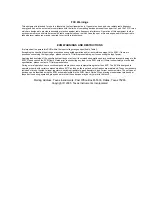
www.ti.com
1.4
Jumper Descriptions
1.5
Data Input Modes
Introduction
1.3.3
J3 – Interface Connector
This connector is used to connect the TLC5940 EVM to the TUSB3210 interface board. The signals are
the same as on connector J1.
Table 4. J3 – Power Connector
Pin
Direction
Pin Symbol
Signal Name
Function
Number
(at board)
19
/22V_EN
22V Enable
In
This is an active low enable signal that turns on the 22V
power supply that is used to program the internal EEPROM
on the TLC5940 ICs.
20
VRPG_IN
VPRG Data
In
This signal is buffered and combined with the /22V_EN signal
to set the VPRG voltage on the TLC5940 ICs.
21
XDOWN
Error signal
Out
Error flag (LOD and TEF) output. Note: XDOWN of all three
devices is tied together.
22
DCPRG
DC PRG Mode
In
Selects either the internal register or the internal EEPROM
when in DOT correction mode
23
GSCLK
GS PWM Clock
In
Grayscale clock signal for 12-bit PWM dimming
24
BLANK
Output enable
In
Output enable for all channels. Outputs are disabled when
BLANK is high.
25
XLAT
Data latch
In
Rising edge latches data from shift register into the device
26
SCLK
Serial data clock
In
Serial data input clock
27
SOUT_B
Serial data output blue
Out
Serial data output for the blue LED IC. This is also the serial
data output in cascade mode
28
SIN_BLUE
Serial data input blue
In
Serial data input for the blue LED IC
29
SOUT_G
Serial data output green
Out
Serial data output for the green LED IC
30
SIN_GREEN
Serial data input blue
In
Serial data input for the blue LED IC
31
SOUT_R
Serial data output red
Out
Serial data output for the red LED IC
32
SIN_RED
Serial data input red
In
Serial data input for the red LED IC. This is also the serial
data input when all three TLC5940 ICs are connected in
cascade mode (serially).
43,44
3.3V
3.3V Bias
In
This pin is the 3.3V bus from the TUSB3210 interface board.
It is not connected to the V_CC pins on the PWB. It can be
connected to V_CC on the PWB by inserting a 0-
Ω
resistor in
R18.
47, 48,
GND
Ground
Power
Signal ground
49, 50
1.4.1
JP1, JP2, JP3 – LED Test Current
These jumpers provide an easy place to measure the current flowing through the D0 red, green, and blue
LEDs. To measure the current, through an LED, remove the jumper and connect a current meter across
the jumper pins. Note that no current can flow through the LEDs if the jumpers are removed and a current
meter is not installed.
The TLC5940EVM-106 can be configured to accept data in two different modes: serially or in parallel. The
default configuration is serial mode. The EVM can be reconfigured for parallel data input by modifying
resistors R2, R3, R4, R6, R7, and R8 according to Table 5.
SLVU139 – September 2005
TLC5940 EVM
5
Содержание TLC5940 EVM
Страница 8: ...www ti com 2 1 Layout Board Layout Figure 2 Assembly Layer TLC5940 EVM 8 SLVU139 September 2005 ...
Страница 9: ...www ti com Board Layout Figure 3 Top Layer Routing SLVU139 September 2005 TLC5940 EVM 9 ...
Страница 10: ...www ti com Board Layout Figure 4 Layer 2 Routing TLC5940 EVM 10 SLVU139 September 2005 ...
Страница 11: ...www ti com Board Layout Figure 5 Layer 3 Routing SLVU139 September 2005 TLC5940 EVM 11 ...
Страница 12: ...www ti com Board Layout Figure 6 Bottom Layer Routing TLC5940 EVM 12 SLVU139 September 2005 ...





































